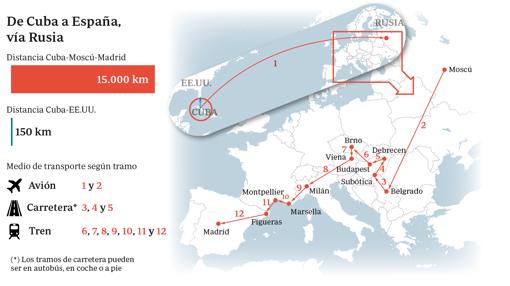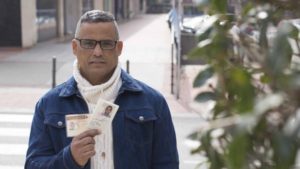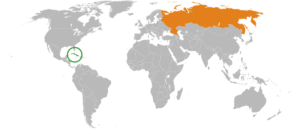Comparado con la mayoría de cubanos, José Alberto Pérez era un privilegiado. Licenciado en Matemáticas e Informática en Volvogrado (antigua Stalingrado), prosperó como «cuentapropista» (autónomo), importando ropa de Rusia. Pero una nueva norma limitó en 2014 la cantidad de mercancía que podía introducir y su negocio se fue a pique, de modo que decidió quedarse en Rusia. Entonces empezaron los problemas en ese país: conflicto en Ucrania, subidas de precios y el rublo por los suelos. Además, su matrimonio con una rusa se rompió. Así fue como decidió venir a España.
Viajes hacia la Libertad.
Decenas de cubanos llevan meses varados en territorio serbio, en medio de un paisaje nevado muy distinto a la cálida Cuba que dejaron atrás. Según el Alto Comisionado de Naciones Unidas para los Refugiados (Acnur), 168 permanecen en centros de retención de ese país de la antigua Yugoslavia. «Decidimos abandonar Cuba porque no había libertad. Estábamos cansados de la represión, era demasiado», declara a Reuters Tania Hernández, que se trasladó a Serbia junto a su familia el pasado mes de agosto tras vender su vivienda en La Habana y cree que viajar España resulta más sencillo que entrar en EE.UU.
En el caso de José Alberto Pérez, de 47 años, su aventura comenzó el 5 de marzo de 2015. Ese día tomó un vuelo de Moscú a Belgrado, llevando un billete de vuelta y una reserva de hotel falsos para fingir que solo iba de visita. «En Moscú hay cubanos que hacen negocio con esto y te meten en la cabeza que te van a dar asilo», asegura.
Se dirigió con tres compatriotas a la ciudad fronteriza de Subótica e intentó entrar en Hungría a través del bosque. Una patrulla los capturó a 150 metros de la línea divisoria. «Se asombraron de que fuéramos cubanos, porque por allí solían cruzar pakistaníes o afganos. Nunca habían detenido a un cubano». Tras un juicio rápido, les dieron cinco días para abandonar el país. «Pero a esas alturas ya no queríamos regresar a Rusia, y a Cuba mucho menos, así que volvimos a intentarlo», continúa su relato.
Contactaron con un «coyote» serbio llamado «El hermano», que por 150 dólares les guió para atravesar la frontera. Les llevó a una casa abandonada y les dejó de madrugada ante una valla. Saltaron esa y otras dos alambradas y, arrastrándose por campos de cultivo y maleza, penetraron en Hungría. Caminaron diez kilómetros hasta encontrar a unos policías a los que dijeron que querían asilo.
En pésimas condiciones
Tras pasar por un par de albergues, les llevaron a un campo de refugiados en Debrecen, donde las condiciones higiénicas eran deplorables. «Yo contraje fiebre, tenía 40 grados, y no me dieron ningún tipo de atención», recuerda. Allí coincidió con más cubanos y supo que en Hungría no les concedían asilo, ni siquiera a quienes militaban en organizaciones disidentes. En cambio, se corrió la voz de que en la República Checa se lo daban a todos. Así que se fue a Budapest y de allí hasta la ciudad checa de Brno, en cuyas cercanías había otro campamento. «No tenía nada que ver con el de Hungría, era como un hotel», señala. Allí se juntaron hasta 45 cubanos, pero también les denegaron el asilo por haberlo pedido antes en otro país. Las autoridades les ofrecieron una salida: si escapaban del campamento sin que la policía los detuviera, a los 18 meses podían volver y se les concedería. Así que muchos se marcharon.
Buena parte de ellos cogieron rumbo a España. José Alberto fue a Viena y de ahí a Milán, Marsella, Montpellier y Figueras, desde donde viajó a Madrid gracias a unos allegados cubanos que viven en la capital. Una mujer que había cruzado con él la frontera serbio-húngara acabó yendo en 2016 a EE.UU., donde le esperaba su pareja, con lo que recorrió medio mundo para acabar a solo 150 kilómetros de Cuba.
El número de solicitantes cubanos de asilo en España se duplicó el pasado año hasta los 80, según cifras provisionales del Ministerio del Interior, aunque llegan muchos otros que no piden ese estatus. Uno de ellos es José Alberto Pérez. Tiene planes de boda en Fuenlabrada con su actual pareja española, Cristina, aunque de momento sigue en situación irregular y no puede trabajar de forma legal.
Agencies/ABC/Manuel Trillo/Internet Photos/Excerpts/Arnoldo Varona/TheCubanHistory.com
THE CUBAN HISTORY, HOLLYWOOD.
FOLLOW US ON TWITTER AND FACEBOOK. THECUBANHISTORY.COM

HAS BEEN OPENED IN CUBA NEW ROUTE TO LIBERTY, RUSSIA.
Compared with the majority of Cubans, José Alberto Pérez was a privileged one. Graduated in Mathematics and Computer Science in Volvograd (formerly Stalingrad), he prospered as a “self-employed” (freelancer), importing clothes from Russia. But a new rule limited the amount of merchandise he could enter in 2014 and his business went berserk, so he decided to stay in Russia. Then began the problems in that country: conflict in Ukraine, price rises and ruble in the soil. In addition, his marriage to a Russian woman broke. That’s how he decided to come to Spain.
Travel to Freedom.
Dozens of Cubans have been stranded for months in Serbian territory, in the middle of a snowy landscape very different from the warm Cuba they left behind. According to the United Nations High Commissioner for Refugees (UNHCR), 168 remain in detention centers in that country of the former Yugoslavia. “We decided to leave Cuba because there was no freedom. We were tired of the repression, it was too much, “Tania Hernandez, who moved to Serbia with his family last August after selling his home in Havana, believes that traveling Spain is easier than entering the US. UU.
In the case of José Alberto Pérez, 47, his adventure began on March 5, 2015. That day he took a flight from Moscow to Belgrade, carrying a back ticket and a fake hotel reservation to pretend he was only visiting . “In Moscow there are Cubans who do business with this and put you in the head that will give you asylum,” he says.
He went with three compatriots to the border city of Subotica and tried to enter Hungary through the forest. A patrol captured them 150 meters from the dividing line. “They were astonished that we were Cubans, because there they used to cross Pakistani or Afghans. They had never stopped a Cuban. ” After a quick trial, they were given five days to leave the country. “But by that time we did not want to return to Russia, and Cuba much less, so we tried again,” continues his story.
They contacted a Serbian “coyote” called “El hermano”, who for 150 dollars guided them to cross the border. He took them to an abandoned house and left them at dawn before a fence. They jumped that and two other barbed wire and, crawling through fields of weeds and weeds, penetrated into Hungary. They walked ten miles to find some policemen whom they said they wanted asylum.
In terrible conditions
After passing through a couple of shelters, they were taken to a refugee camp in Debrecen, where hygienic conditions were deplorable. “I got fever, I was 40 degrees, and they did not give me any kind of attention,” he recalls. There he coincided with more Cubans and knew that in Hungary they did not grant them asylum, not even to those who militated in dissident organizations. Instead, word got out that in the Czech Republic they gave it to everyone. So he went to Budapest and from there to the Czech city of Brno, in the vicinity of which there was another camp. “It had nothing to do with Hungary, it was like a hotel,” he says. There they were gathered up to 45 Cubans, but they were also denied asylum for having asked for it before in another country. The authorities offered them a way out: if they escaped from the camp without being detained by the police, they could return at 18 months and they would be granted. So many left.
A good part of them took course to Spain. Jose Alberto went to Vienna and from there to Milan, Marseilles, Montpellier and Figueras, from where he traveled to Madrid thanks to some close Cubans who live in the capital. A woman who had crossed with him the Serbian-Hungarian border ended up going in 2016 to USA, where his partner was waiting for him, which traveled half a world to finish just 150 kilometers from Cuba.
The number of Cuban asylum seekers in Spain doubled last year to 80, according to provisional figures from the Interior Ministry, although many others do not ask for that status. One of them is José Alberto Pérez. She has plans for a wedding in Fuenlabrada with her current Spanish partner, Cristina, although she is still in an irregular situation and can not work legally.
Agencies / ABC / Manuel Trillo / Internet Photos / Excerpts / Arnoldo Varona / TheCubanHistory.com
THE CUBAN HISTORY, HOLLYWOOD.






